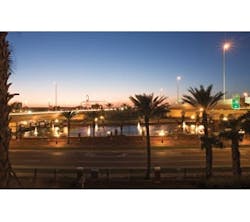Ybor City, located northeast of Tampa’s downtown, is one of only two National Historic Landmark Districts in Florida.
Red brick buildings, wrought iron balconies and narrow brick streets give it an old-world charm that is a refreshing contrast from the area’s Gulf beaches and gleam of the city’s skyscrapers. Founded in the 1880s by cigar manufacturers and populated by a diverse blend of immigrants from Spain, Cuba and Italy, Ybor City produced millions of cigars annually until the 1930s. Since that time it has endured some tough transitions visited upon it by the decline of cigars (replaced in the 1950s by the then-fashionable cigarette) and unintended consequences of the Federal Highway Act of 1956.
“In the early 1960s, Tampa was one of the first to get funding for interstate construction,” said Elaine Illes, a consultant with Florida Department of Transportation (FDOT) District 7. “As a result I-4 cut through Ybor City separating its commercial and residential districts.”
During that same time, Ybor City’s major corridors, 21st and 22nd streets, became three-lane truck routes to accommodate the increased truck traffic to the nearby port of Tampa, whose shipping volume doubled after it was dredged. The additional traffic and rumble of large trucks continued to erode the historic district’s attraction.
Using some clout
The 21st/22nd Street Urban Corridor Project, set to begin in the fall of 2014 and take two years to complete, is the final step in a list of enhancements FDOT has taken to improve Ybor City’s traffic problems while assisting with re-establishing the district as a livable historic community. FDOT officials are hopeful it will provide substantial benefit to the district’s residences and businesses.
Illes said that FDOT’s motivation for the project is founded in the agency’s belief that context-sensitive design is essential to the idea that transportation projects should be “planned and implemented with respect for the natural and urban surroundings”
According to Illes, the impetus to improve Ybor City began soon after the completion of I-4 in 1965 when residents and businesses complained that it had ruined the district. It was not until 24 years later in 1989 that the historic community and FDOT completed a master plan, receiving its Environmental Impact Statement (EIS) signoff in 1997. The first design, reconstruction of I-4 in Ybor City, was completed in 2005. Engaging local residents, FDOT worked with Tampa’s Barrio Latino Commission to present a plan to make I-4 aesthetically acceptable. Both sides agreed to design elements that complemented the architecture of the district.
“Because Ybor City was designated a landmark district, FDOT had more clout to include the type of improvements that would mitigate the interstate’s intrusion to the historic district,” said Illes.
According to FDOT Project Manager Mary Lou Godfrey, the I-4 reconstruction project included motif-designed brick noise retaining walls to limit right-of-way (ROW) takings, although 54 residences and historic properties were relocated and 35 buildings rehabilitated. The ROW purchase included a 64-ft median to provide future expansion for mass transit. Other amenities included construction of a pedestrian plaza that divides 21st and 22nd streets and is anchored by a large ornate median fountain featuring four water plumes.
“More importantly,” said Godfrey, “bridge spans were expanded to accommodate pedestrians, and new structures (and) underpasses were built to provide pedestrian connectivity throughout the community, previously separated by I-4.”
To reflect the district’s character, she said the bridges featured concrete arches over balustrades in brick-patterned mechanically stabilized earth (MSE) walls, bridge piers wrapped in brick and fiberglass arched panels and art medallions incorporating historic scenes of times past.
FDOT completed the I-4 reconstruction in 2008, the same year the agency initiated design of the second improvement, the I-4/Selmon Expressway, which would eventually divert disruptive truck traffic from 21st and 22nd streets. The 5-mile elevated roadway links I-4 with the port, bypassing Ybor City. Started in the spring of 2010 and now operational, the project will be completed by the end of 2014.
Two functioning streets
With I-4 reconstructed and the completed bypass diverting trucks from 21st and 22nd streets, Godfrey said that FDOT prepared for the final piece of the master plan, the Urban Corridor Project that would include road engineering, architectural lighting, hardscape and landscaping utility work. In 2010, FDOT, Ybor City Development Corp.—a nonprofit board, part of Tampa’s Economic Development Commission—and community stakeholders met to explore what improvements Ybor City wanted, since plans called for those streets to revert back to the city when the project was complete.
“Since our goal was to preserve the historic fabric and architectural integrity of the district, clearly we wanted to make sure they were a partner in the planning,” said Godfrey, “especially if they were going to take it over.”
Godfrey said FDOT drafted a transfer agreement at the end of 2010 that allowed the redevelopment of 21st and 22nd streets to begin once the I-4 Connector was open to truck traffic. In 2011, then-Tampa-Mayor Pam Ioria and FDOT signed the agreement.
After a three-year planning period, the three stakeholders, as well as the consulting designer Wade-Trim, agreed to a final design to restore Ybor City.
Vince Pardo, manager of Ybor City Development Corp., said that virtually every stakeholder participated in the vision plan for the Urban Corridor Project.
“Restaurants, hotels, professional offices, neighborhood associations and property owners made up the advisory group that participated in the plan,” said Pardo. “They had input into every aspect of the project—the design, parking and furniture. Our vision gave the FDOT consultant the specs to come up with the plan. They did a great job incorporating the recommendations of the community and memorializing what 21st and 22nd streets should look like.”
More importantly, Pardo said the barriers to the east and west side of the district were eliminated, allowing 21st and 22nd to become two functioning streets at the heart of Ybor City.
Steve Wallace, senior project manager for Wade-Trim, said the most important element of the redevelopment plan called for reducing the current three-lane configuration both northbound and southbound on 21st and 22nd streets to two lanes in each direction from 3rd Avenue to 10th Avenue. The 15-block project also provides pedestrian and bike connectivity throughout the corridor and to other areas of the city. Hardscape features such as granite curbing, brick crosswalks on all four approaches at signalized intersections and side-street crosswalks will be added during the 1-mile stretch between S.R. 60 and Columbus Avenue. Other features include historic scored sidewalks, benches, trash receptacles, 87 five-globe lights, nearly 200 new trees/tree grates, Americans with Disabilities Act (ADA) upgrades, 34 additional parking spaces and bus bays.
“Interestingly, we studied archival records and photos of Ybor City dating back to the early 1900s before coming up with the plan,” said Wallace. “We identified features and tendencies from that era, although we could not match it exactly because of the dirt roads and cobblestone prevalent at that time and, of course, now we use pavement.”
He said that they also studied the plant species of that era that had a Cuban accent and chose palms and crape myrtles that were representative of that country and Florida. He added that the entrances of Ybor City would be lined with poincianas that bloom with red flowers creating an explosion effect.
Cue the complicated
Wallace said the planning began in 2012 with the first phase to review the costs of construction to see if it was affordable within the $5.3 million budget and, more importantly, verify that the storm sewer was in good enough shape to begin.
“If the storm sewer was in need of repair we could not have proceeded with all the neat stuff,” said Wallace, adding that “phase two was the redesigning of 21st and 22nd street from three lanes into two-lane one-way pairs.
According to Wallace the “complicated” project will begin this fall.
“In addition to Tampa wanting to take the opportunity to put in a new water line, the city, FDOT and YBCD each had a lot of say so in what this design was going to look like,” he said. “It’s hard to make one client happy, two nearly impossible and three, you can imagine the give and take.”
Wallace said most everything in the project was considered sensitive and could not be broken.
“The challenges were heightened because the state and city had different and sometimes opposing criteria. But in the end everyone worked hard and got it right.” R&B



